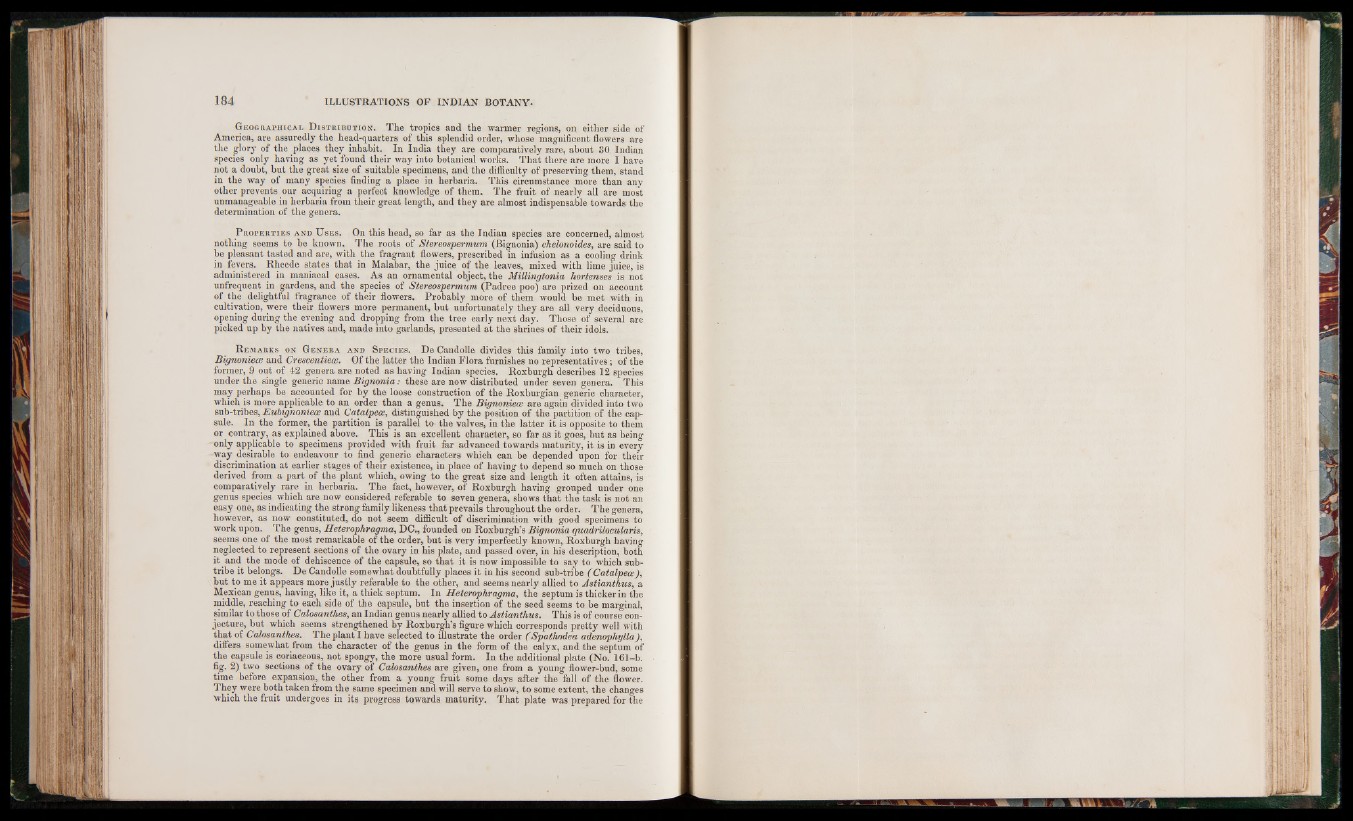
Geographical D istribution. The tropics and the warmer regions, on either side of
America, are assuredly the head-quarters of this splendid order, whose magnificent flowers are
the glory of the places they inhabit. In India they are comparatively rare, about 80 Indian
species only having as yet found their way into botanical works. That there are more I have
not a doubt, but the great size of suitable specimens, and the difficulty of preserving them, stand
in the way of many species finding a place in herbaria. This circumstance more than any
other prevents our acquiring a perfect knowledge of them. The fruit of nearly all are most
unmanageable in herbaria from their great length, and they are almost indispensable towards the
determination of the genera.
P roperties and U ses. On this head, so far as the Indian species are concerned, almost
nothing seems to be known. The roots of Stereospermum (Bignonia) chelonoides, are said to
be pleasant tasted and are, with the fragrant flowers, prescribed in infusion as a cooling drink
in fevers. Rheede states that in Malabar, the juice of the leaves, mixed with lime juice, is
administered in maniacal cases. As an ornamental object, the Millingtonia hortenses is not
unfrequent in gardens, and the species of Stereospermum (Padree poo) are prized on account
of the delightful fragrance of their flowers. Probably more of them would be met with in
cultivation, were their flowers more permanent, but unfortunately they are all very deciduous,
opening during the evening and dropping from the tree early next day. Those of several are
picked up by the natives and, made into garlands, presented at the shrines of their idols.
R emarks on G enera and Species. De Candolle divides this family into two tribes,
Bignoniece and Crescentiece. Of the latter the Indian Flora furnishes no representatives; of the
former, 9 out of 42 genera are noted as having Indian species. Roxburgh describes 12 species
under the single generic name Bignonia: these are now distributed under seven genera. This
may perhaps be accounted for by the loose construction of the Roxburgian generic character,
which is more applicable to an order than a genus. The Bignoniece are again divided into two
sub-tribes, Eubignoniece and Catalpece, distinguished by the position of the partition of the capsule.
In the former, the partition is parallel to the valves, in the latter it is opposite to them
or contrary, as explained above. This is an excellent character, so far as it goes, but as being
only applicable to specimens provided with fruit far advanced towards maturity, it is in every
way desirable to endeavour to find generic characters which can be depended upon for their
discrimination at earlier stages of their existence, in place of having to depend so much on those
derived from a part of the plant which, owing to the great size and length it often attains, is
comparatively rare in herbaria. The fact, however, of Roxburgh having grouped under one
genus species which are now considered referable to seven genera, shows that the task is not an
easy one, as indicating the strong family likeness that prevails throughout the order. The genera,
however, as now constituted, do not seem difficult of discrimination with good specimens to
work upon. The genus, Heterophragma, DC., founded on Roxburgh’s Bignonia quadrilocularis,
seems one of the most remarkable of the order, but is very imperfectly known, Roxburgh having
neglected to represent sections of the ovary in his plate, and passed over, in his description, both
it and the mode of dehiscence of the capsule, so that it is now impossible to say to which subtribe
it belongs. De Candolle somewhat doubtfully places it in his second sub-tribe ( Catalpeoe),
but to me it appears more justly referable to the other, and seems nearly allied to Astianthus, a
Mexican genus, having, like it, a thick septum. In Heterophragma, the septum is thicker in the
middle, reaching to each side of the capsule, but the insertion of the seed seems to be marginal,
similar to those of Calosanthes, an Indian genus nearly allied to Astianthus. This is of course conjecture,
but which seems strengthened by Roxburgh’s figure which corresponds pretty well with
that of Calosanthes. The plant I have selected to illustrate the order ( Spathodea adenophylla),
differs somewhat from the character of the genus in the form of the calyx, and the septum of
the capsule is coriaceous, not spongy, the more usual form. In the additional plate (No. 161-b.
fig. 2) two sections of the ovary of Calosanthes are given, one from a young flower-bud, some
time before expansion, the other from a young fruit some days after the fall of the flower.
They were both taken from the same specimen and will serve to show, to some extent, the changes
'which the fruit undergoes in its progress towards maturity. That plate was prepared for the